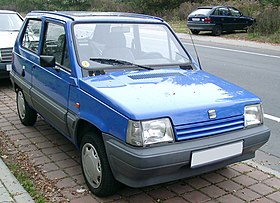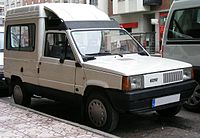SEAT Marbella
| SEAT Panda SEAT Marbella | |
|---|---|
 SEAT Marbella | |
| Overview | |
| Manufacturer | SEAT |
| Production | 1980–1986 (Panda) 1986–1998 (Marbella) |
| Assembly | Pamplona, Spain Barcelona, Spain |
| Body and chassis | |
| Class | City car (A) |
| Body style | 3-door hatchback |
| Related | Fiat Panda Mk1 |
| Dimensions | |
| Wheelbase | 2,160 mm (85 in) |
| Length | 3,475 mm (136.8 in) |
| Width | 1,510 mm (59 in) |
| Height | 1,400 mm (55 in) |
| Chronology | |
| Successor | SEAT Arosa |
The SEAT Panda (codenamed 141A) was a badge-engineered Fiat Panda produced by SEAT from 1980 to 1986, in the company's Landaben plant in the Spanish city of Pamplona (from February 1980 until 29 April 1983, when its production ended in that plant) and also in the Zona Franca plant in Barcelona.[1] After the break in the partnership between SEAT and Fiat, the SEAT Panda model was restyled and renamed. It received a slight restyling in 1983, with a new grille and other slight differences.
History
The "Marbella" badge was first used for the 1983 model year, on a luxurious version of the SEAT Panda.[2]
After a second, more thorough restyling in December 1986,[3] it received the SEAT Marbella nameplate (codenamed 28 for SEAT Marbella and 028A for SEAT Marbella box) and was produced by SEAT until 1998 in the company's Zona Franca plant in Spain. The end of Marbella production in 1998 also meant the end of vehicle production in that factory.[4] The SEAT model didn't receive the mechanical and cosmetic tweaks (such as the loss of front window quarter-lights) applied to Fiat Pandas "Mark II"s from 1986[5] but was instead subjected to those from SEAT.
Differences

The obvious differences between a Panda and a Marbella are at the front and back of the car where head and tail lights and boot panels are different, the Marbella gaining a pronounced slope to the front panel.
The Marbella featured a boot with capacity of 272 litres, expandable to 1,088 litres when the rear seats are folded.[6]
Powertrain
Mechanically, the Panda borrowed heavily from the Fiat "parts bin", using engines and transmissions from the Fiat 127. The engine is an inline four-cylinder with 40 PS (29 kW) and 903 cc. This proved adequate for this light car which weighed in at about 680 kg. A 60 PS (44 kW) kit to make a more powerful SEAT Panda Abarth version was also on offer, sold in Spain by a company called Apicsa.[7] Shortly after introduction, a smaller-hearted version corresponding to the Italian two-cylinder model was added. Called the "Panda 35", it had a smaller 843 cc version of the engine, a development of the engine originally fitted to the SEAT 850 beginning in the mid-sixties. To set it further apart from the "45", a lower compression rate was chosen. Nonetheless, the smaller engine had to work that much harder to keep up, and in practice the fuel economy savings were negligible.[8]
When the Marbella was introduced in December 1986, the smaller 843 cc version continued to be available. This low-priced version produced only 34 PS (25 kW) at 5,600 rpm and was not available with the five-speed transmission.[9] Top speed for the bigger engine was 131 km/h (81 mph), while the 850 could only reach 125 km/h (78 mph).[3] 903 cc version of the engine later got electronic injection and reduced its size to 899 cc.[10]
Equipment levels
Several differently labeled models were produced during the lifetime of the car, with few corresponding significant changes in specifications. Common models include the L, Special, XL, GL, and GLX, but there were many "special editions", especially later in the life of the Marbella. In September 1989 the "Black", "Red", and "Yellow" specials were added, "Blue", "Green", "CLX", and "Jeans" joined in September 1990. Various export markets also received market specific editions, such as the "Le Jouet" series marketed in France in the early nineties.[3]
Derivatives
Commercial version


SEAT Terra (24/024A, 1987–1996)
A van version of the Marbella, called the SEAT Terra (codenamed 24 for SEAT Terra and 024A for SEAT Terra box), was produced in Spain from 1987 until 1996 when this model was meant to be replaced from its successor, the SEAT Inca. The SEAT Terra shared the underpinnings and front of the Marbella, but its back was replaced by a large, high metal box; there was also a load rack above the cab roof. It was very popular in Spain, and was also available in export markets.
SEAT Trans
Before this, a van based on the Marbella's predecessor (the SEAT Panda) was also available until 1986. In much the same configuration as the Terra, it was called the SEAT Trans and was extremely similar to the Fiat Panda's commercial version [dead link].
Popemobile

In 1982 SEAT produced in its plant in Zona Franca a popemobile car, a modified version derived from the SEAT Panda, which was used during the Pope John Paul II's 1982 visit in Spain. That specific vehicle was an 'all-open-air' car with a grab handle in front so that the Pope could stand still to greet the crowds, while the vehicle was in motion.[11] In that car the Pope entered the FC Barcelona Camp Nou soccer stadium[12] driving through the assembled crowds celebrating mass for a congregation of over 121,000 on 17 November 1982.
Emelba derivatives


The Spanish company Emelba produced several derivative models from the SEAT Panda among others:
- Emelba Elba Cinco puertas (5-door), the sole 5-door version of the SEAT Panda
- Emelba Pandita 4x4
- Emelba Chato/903
- a SEAT Panda equipped with a Daihatsu diesel engine
Concept cars
In the 1991 Frankfurt Motorshow, SEAT presented the SEAT Marbella Playa concept car.[13]
Motorsport

The SEAT Panda/Marbella has not only taken part and won podium positions in various race events, but also has formed its own 'Copa Panda' one-make rally series, a rally trophy - created in 1980 by SEAT and its motorsport competition director at the time José Juan Pérez de Vargas, standing next to the brand's 'Copa Fura' circuit cup[14] - which was addressed to young drivers aiming to come close to the motorsport experience.
The most renowned rally driver who emerged from that competition series was the Spanish Carlos Sainz, the winner in the first edition of the 'Copa Panda' rally. Due to his win SEAT granted to him as an award a SEAT Panda 45 Grupo 2 rally car, under which he won his first title in the first already season of the 'Copa Panda' championship in 1982.
Together with the integration of the Spanish brand to the Volkswagen group, SEAT was able to strengthen even more its involvement in motorpsort activities with the formation of the SEAT Sport department in 1985. Since the SEAT Panda model had been replaced in SEAT's range by the SEAT Marbella in 1986, it was the time that the 'Copa Panda' cup should be succeeded too by the 'Copa Marbella' one. The 'Copa Marbella' formed part of the 'Campeonato de España de Rallyes de Tierra' national track championship schedule during eight years, to be ultimately superseded by the 'Copa Ibiza' rally series.[15] In the 'Campeonato de España de Rallyes de Tierra' championship it was the SEAT Marbella Proto, a car powered by a 1.8L 4-cylinder motor derived from the VW Polo G40[16][17] equipped with a compressor delivering a horsepower of 140 hp, under which SEAT won the 1988 championship title[18] while in the next season Antonio Rius on the wheel of the Marbella won the two-wheel drive class. In the following years the Marbella was also driven by many drivers among which Àlex Crivillé, Juan Garriga and Jordi Tarrés,[19] with the latter competing successfully against much more powerful cars - like the Lancia Delta - on the driver's seat of a 620 kg lightweight Marbella.[20]
References
- ^ El 29 de abril de 1983 salió el último modelo SEAT Panda de las instalaciones de Landaben. VW Navarra.es.
- ^ Büschi, Hans-Ulrich, ed. (March 10, 1983). "Automobil Revue '83" (in German and French). 78. Berne, Switzerland: Hallwag, AG: 491–492. ISBN 3-444-06065-3.
{{cite journal}}: Cite journal requires|journal=(help) - ^ a b c Quattroruote: Tutte le Auto del Mondo 1992 (in Italian). Milano: Editoriale Domus S.p.A. 1992. p. 923.
- ^ SEAT history 1999-1990. SEAT.com.
- ^ "Fiat Panda and Seat Marbella Owners Club UK - Home". Panda-marbella.webs.com. Retrieved 2011-07-16.
- ^ SEAT Marbella 903 cat Special http://car4you.quattroruote.it/AppPortal/Page/Public/VehicleTechnical.aspx?VehicleID=3469804
- ^ Silva, Jorge, "Seat Panda Abarth", Velocidad (in Spanish), Piel de Toro, archived from the original on 2008-05-07
- ^ Mallo, Alberto (1981-01-17), "Prueba: Seat Panda 35", Velocidad (in Spanish) (1001), Piel de Toro
- ^ Büschi, Hans-Ulrich, ed. (5 March 1987). Automobil Revue 1987 (in German and French). Vol. 82. Berne, Switzerland: Hallwag AG. p. 508. ISBN 3-444-00458-3.
- ^ http://www.autoweek.nl/auto/15362/seat-marbella-special
- ^ The Evolution Of The Popemobile. Jalopnik.com.
- ^ Where JFK meets the Queen and Khrushchev. Audiusanews.com.
- ^ +Interesante. 60 años de Seat. Descubrimos los secretos de la Nave A122. Motor16.com.
- ^ la firma continuó patrocinando competiciones de promoción, como la Copa Fura de circuitos y la Copa Panda de rallyes http://archivo.marca.com/automovilismo/rallyes/seat.html
- ^ Copa Seat Panda http://www.autohebdosport.es/rallyes/copa-seat-panda
- ^ Dabei handelte es sich um einen Seat Marbella, dem ein überarbeiteter 140 PS starker Turbomotor eines VW Polo G40 implantiert wurde. http://www.marberra.de/HistorieMarbellaTerra/HistorieMarbella.html
- ^ Crea un Seat Marbella equipado con un motor con compresor del Polo G40. http://eman-egurre.es/Pilotos_Rius.htm
- ^ The SEAT Marbella Proto is equipped with a compressor, allowing for 140 hp, and wins the championship. http://www.seat.com.cy/new/company/seat-sport.php
- ^ At some promotional events the Marbella Proto models were driven by international motorcycle champions such as Àlex Crivillé, Joan Garriga and Jordi Tarrés. http://www.seat-sport.com/en/compania/seat-competicion.php
- ^ El secreto de este modelo para batir a coches tan brutales como el Lancia Delta es que redujeron el peso al máximo (620 kg) http://www.autobild.es/reportajes/todos-los-modelos-campeones-de-seat-40-a%C3%B1os-dando-gas
